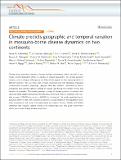Files in this item
Climate predicts geographic and temporal variation in mosquito-borne disease dynamics on two continents
Item metadata
| dc.contributor.author | Caldwell, Jamie M | |
| dc.contributor.author | LaBeaud, A Desiree | |
| dc.contributor.author | Lambin, Eric F | |
| dc.contributor.author | Stewart-Ibarra, Anna M | |
| dc.contributor.author | Ndenga, Bryson A | |
| dc.contributor.author | Mutuku, Francis M | |
| dc.contributor.author | Krystosik, Amy R | |
| dc.contributor.author | Ayala, Efraín Beltrán | |
| dc.contributor.author | Anyamba, Assaf | |
| dc.contributor.author | Borbor-Cordova, Mercy J | |
| dc.contributor.author | Damoah, Richard | |
| dc.contributor.author | Grossi-Soyster, Elysse N | |
| dc.contributor.author | Heras, Froilán Heras | |
| dc.contributor.author | Ngugi, Harun N | |
| dc.contributor.author | Ryan, Sadie J | |
| dc.contributor.author | Shah, Melisa M | |
| dc.contributor.author | Sippy, Rachel | |
| dc.contributor.author | Mordecai, Erin A | |
| dc.date.accessioned | 2022-01-20T11:30:36Z | |
| dc.date.available | 2022-01-20T11:30:36Z | |
| dc.date.issued | 2021-02-23 | |
| dc.identifier | 277522720 | |
| dc.identifier | 3132e9ea-8523-4fdc-8a92-b7fa1c6491ff | |
| dc.identifier | 33623008 | |
| dc.identifier | 85101300385 | |
| dc.identifier.citation | Caldwell , J M , LaBeaud , A D , Lambin , E F , Stewart-Ibarra , A M , Ndenga , B A , Mutuku , F M , Krystosik , A R , Ayala , E B , Anyamba , A , Borbor-Cordova , M J , Damoah , R , Grossi-Soyster , E N , Heras , F H , Ngugi , H N , Ryan , S J , Shah , M M , Sippy , R & Mordecai , E A 2021 , ' Climate predicts geographic and temporal variation in mosquito-borne disease dynamics on two continents ' , Nature Communications , vol. 12 , 1233 . https://doi.org/10.1038/s41467-021-21496-7 | en |
| dc.identifier.issn | 2041-1723 | |
| dc.identifier.other | PubMedCentral: PMC7902664 | |
| dc.identifier.other | ORCID: /0000-0003-3617-2093/work/106838531 | |
| dc.identifier.uri | https://hdl.handle.net/10023/24716 | |
| dc.description | Funding: J.M.C., A.D.L., E.F.L., and E.A.M. were supported by a Stanford Woods Institute for the Environment—Environmental Ventures Program grant (PIs: E.A.M., A.D.L., and E.F.L.). E.A.M. was also supported by a Hellman Faculty Fellowship and a Terman Award. A.D.L., B.A.N., F.M.M., E.N.G.S., M.S.S., A.R.K., R.D., A.A., and H.N.N. were supported by a National Institutes of Health R01 grant (AI102918; PI: A.D.L.). E.A.M., A.M.S.I., and S.J.R. were supported by a National Science Foundation (NSF) Ecology and Evolution of Infectious Diseases (EEID) grant (DEB-1518681), and A.M.S.I. and S.J.R. were also supported by an NSF DEB RAPID grant (1641145). E.A.M. was also supported by a National Institute of General Medical Sciences Maximizing Investigators’ Research Award grant (R35GM133439) and an NSF and Fogarty International Center EEID grant (DEB-2011147). | en |
| dc.description.abstract | Climate drives population dynamics through multiple mechanisms, which can lead to seemingly context-dependent effects of climate on natural populations. For climate-sensitive diseases, such as dengue, chikungunya, and Zika, climate appears to have opposing effects in different contexts. Here we show that a model, parameterized with laboratory measured climate-driven mosquito physiology, captures three key epidemic characteristics across ecologically and culturally distinct settings in Ecuador and Kenya: the number, timing, and duration of outbreaks. The model generates a range of disease dynamics consistent with observed Aedes aegypti abundances and laboratory-confirmed arboviral incidence with variable accuracy (28-85% for vectors, 44-88% for incidence). The model predicted vector dynamics better in sites with a smaller proportion of young children in the population, lower mean temperature, and homes with piped water and made of cement. Models with limited calibration that robustly capture climate-virus relationships can help guide intervention efforts and climate change disease projections. | |
| dc.format.extent | 13 | |
| dc.format.extent | 1298895 | |
| dc.language.iso | eng | |
| dc.relation.ispartof | Nature Communications | en |
| dc.subject | Animals | en |
| dc.subject | Basic reproduction number | en |
| dc.subject | Climate change | en |
| dc.subject | Culicidae/physiology | en |
| dc.subject | Disease outbreaks | en |
| dc.subject | Ecuador/epidemiology | en |
| dc.subject | Geography | en |
| dc.subject | Humans | en |
| dc.subject | Kenya/epidemiology | en |
| dc.subject | Models, biological | en |
| dc.subject | Nonlinear dynamics | en |
| dc.subject | Socioeconomic factors | en |
| dc.subject | Spatio-temporal analysis | en |
| dc.subject | Time factors | en |
| dc.subject | Vector borne diseases/epidemiology | en |
| dc.subject | GE Environmental Sciences | en |
| dc.subject | QR Microbiology | en |
| dc.subject | RA0421 Public health. Hygiene. Preventive Medicine | en |
| dc.subject | DAS | en |
| dc.subject | SDG 3 - Good Health and Well-being | en |
| dc.subject | SDG 13 - Climate Action | en |
| dc.subject.lcc | GE | en |
| dc.subject.lcc | QR | en |
| dc.subject.lcc | RA0421 | en |
| dc.title | Climate predicts geographic and temporal variation in mosquito-borne disease dynamics on two continents | en |
| dc.type | Journal article | en |
| dc.contributor.institution | University of St Andrews. Statistics | en |
| dc.identifier.doi | 10.1038/s41467-021-21496-7 | |
| dc.description.status | Peer reviewed | en |
This item appears in the following Collection(s)
Items in the St Andrews Research Repository are protected by copyright, with all rights reserved, unless otherwise indicated.

